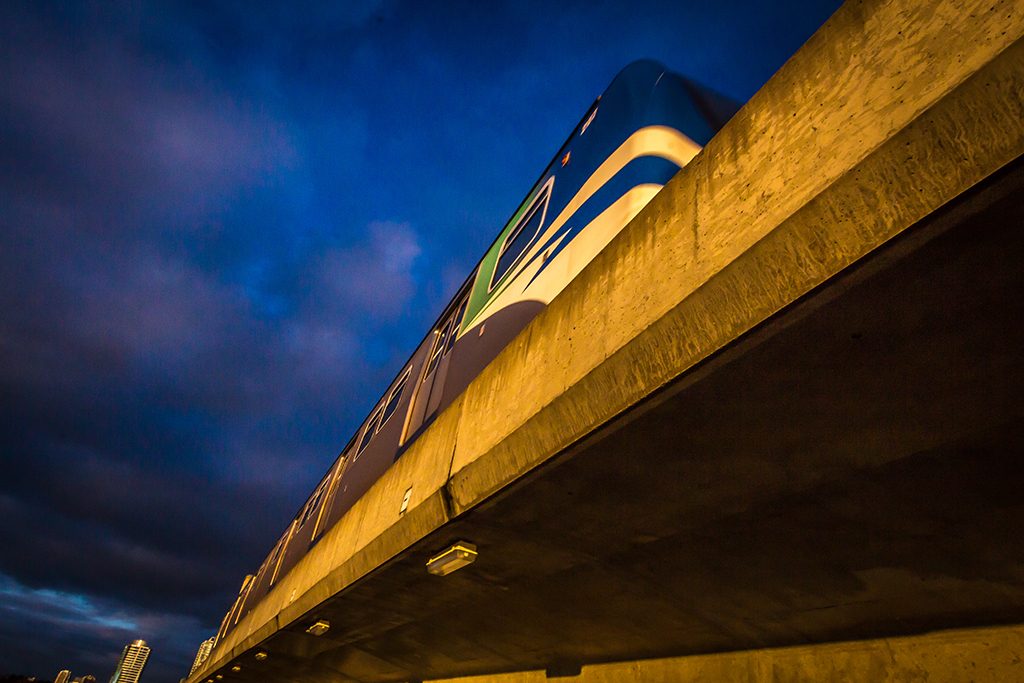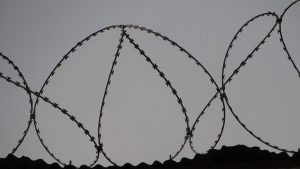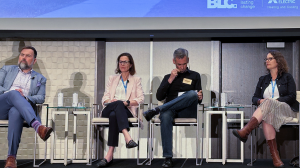Not so long ago, Vancouver was a pleasant and rather sleepy mid-size city separated from the rest of Canada by a wall of mountains and rain. Traffic on the city’s streets was relatively sparse and, for the most part, moved smoothly.
The mountains and rain are still here, but laid-back Vancouver has become a mini-metropolis of 2.5 million people on the eastern slope of the booming Asia Pacific region, with the clogged streets to match.
The trend is expected to continue.
Over the next 30 years, Metro Vancouver will become home to 1 million new residents. And they’ll all need to get to one of the 600,000 new jobs that will be created.
To accommodate some of them, an initiative called the Broadway Subway Project has been proposed by Translink, Metro Vancouver’s transportation network. An extension of the Millennium Line of the SkyTrain light rapid transit system, it will follow a mostly underground 5.7 k.m. route from VCC-Clark Station to Broadway and Arbutus.
The Millennium Line extension to Arbutus is expected to open by 2025.
Translink says “a future phase of investment” will extend SkyTrain from Arbutus all the way westward to the Point Grey campus of the University of British Columbia (UBC).
UBC is currently served by Translink’s 99 B-Line. The fleet of articulated buses moves 60,000 riders a day, making it reportedly the busiest bus route in Canada and the United States.
Opinions of Translink’s proposal vary.
Vancouver architect and developer Michael Geller doubts Translink’s proposal will turn out as it expects.
“Better to fund some other system, such as light rail of the kind Calgary and Edmonton have,” he said. “Another option is to put the money into improving transit south of the Fraser River, in Langley and Surrey, where it’s desperately needed.”
On the other hand, the City of Vancouver, UBC and the Musqueam, Squamish and Tsleil-Waututh Development Corporation say the SkyTrain line should be extended to the university’s campus as soon as possible.
The three parties, including Vancouver Mayor Kennedy Stewart and UBC president Santa Ono, say they intend to press all levels of government to fund the project.
“It’s not surprising people are so supportive of a SkyTrain extension past Arbutus Street,” said Stewart in an announcement. “People want to see transit solutions that will alleviate the major congestion problems along the Broadway corridor, get them to where they need to be more quickly, and integrate into existing and future transit infrastructure across the region. A SkyTrain extension to UBC will help us accomplish all of this.”
And on yet another hand, Professor Patrick Condon of the UBC School of Architecture says a SkyTrain extension to the university is not needed.
“Growth along the corridor is very slow and existing density is absurdly low to justify the line,” said Condon. “Its’ justification comes only if one assumes massive high-rise development at station areas and at UBC, with tens of thousands of units in each one.”
Condon says extending SkyTrain to Arbutus only makes more sense than making it go all the way west to UBC.
“Transit ridership drops off dramatically after Arbutus,” he said. “For years the city was extolling the logic of an Arbutus terminus, thereupon a surface-rail Y system, with one leg [southward] down the Arbutus corridor, one [northward] to downtown, and one [westward] to UBC.”
Condon says that even though such a plan would be “disrespectful of taxpayer dollars, it is far more reasonable than a hugely expensive bored tunnel under the forests of Pacific Spirit Park and low-density West Point Grey.
“Again, this only makes sense if one assumes massive new and unaffordable density along Broadway in Kitsilano, the Jericho Lands, the UBC Golf Course and at UBC itself.”
Condon says there are many better options, each of which is cheaper.
“The integrity of the bus network could be enhanced with more dedicated transit lanes,” he said. “This can be done with greenhouse gas-zero vehicles on 41st Avenue, Marine Drive, 16th Avenue, Broadway and 4th Avenue. There is no shortage of routes available to distribute the demand.”











What we call Skytrain is really two unrelated light-metros:
1) The Canada Line, wan elevated/underground conventional railway that uses standard Electrical Multiple Units (EMU’s) currently supplied by ROTEM of Korea.
2) the Expo and Millennium Lines, which uses the proprietary, Linear Induction Motor (LIM) Movia Automatic Light Metro, with the sole supplier being Bombardier Inc. and the rail division has been recently sold to Alstom.
MALM has gone through 6 name changes and three owners during its 40 year existence and only seven such systems have been built.
Driverless operation is a signalling issue.
The North American standard for building a subway, is a transit route with transit flows in excess of 15,000 persons per hour per direction.
At best, the Broadway corridor sees peak hour traffic flows less around 4,000 pphpd. Claims that Broadway is the busiest transit route in Canada or North America are false; mere propaganda to support subway construction.
Just to operate the Broadway subway (just to Arbutus) will add around 40 million annually to TransLink’s operating budget. Ontario’s MetroLinx, puts the 50 year costs of a subway at $1 billion per km.!
Also remember the subway will operate on a route where the majority of riders will use the deep discounted ($1 a day unlimited travel) U-Pass, thus there will be little revenue generated by the subway.
Also remember the current Millennium Line Line only operates 2 car trains, which are only full during peak hours.
The Broadway subway will just siphon monies away from other parts of the transit system, with little or no benefit, except political prestige.
Visit smartforvancouver.com to see a better alternative
Yes, extension is crucial.
Definitely yes ,sky train should be all way to UBC
It sounds so good.
The City of Vancouver has an at-grade proposal for $500 million, all in, while the subway tunnel, no cars and no depot, is $2.8 billion. Now the Mayor of Vancouver is complaining that the City might need to declare bankruptcy. So who is going to pay for the subway.
History is what current media /politicians/public are not aware of. Promises for Broadway Rapid Transit were made as far back as 1991. What we are missing is
a Master Transportation Plan which many other cities/regions have.
There is no reason to argue about cost now, the city of Vancouver will not allow new rapid transit lines (especially on the west side) unless it is a subway. The city is contributing $100M
(maybe even more ) toward the first phase to Arbutus.
Provincial governments have changed over the last 50 yrs and each time new ideas are put forward instead of using proper evidence based transportation criteria. We should have a “vision” for Vancouver/ Lower Mainland and build transit systems that can support 7 million people from Hope to Whistler. We don’t even have a proper Regional Transit System? We are at least 10 years behind on many projects. Targets that were proposed 20 years ago for 2020 have not been achieved!! It is a mess.
We don’t need the Broadway subway to house the next 20 years of growth. The Vancouver Mayor, and the university president, are promoting Subways-and-Towers to drive up land values. We don’t need government and universities in business for themselves.Vancovuer will add 139,010 people, growing at 1% over the next 20 years (Stats Canada). That’s 6,950 people per year city-wide, or just 139 folks in each of 50 neighborhoods. That growth can be housed building 63 new units per neighborhood, per year, for two decades.
We can achieve that with west coast vernacular, human scale urbanism. In turn, human scale urbanism and switching to alternative fuels will end anthropogenic global warming. Towers are carbon pigs. The Skytrain blights the places it crosses. Combined they have lifted house prices 15 and 17-times over median household incomes pushing our democracy to the brink. We must stop this off-shore capital Tsunami from China and Hong Kong. We must end the trade imbalance with a Chinese Communist Party that ignores human rights, denying a Charter of Rights and Freedoms to its people. Two pandemics (SARS and Covid) have originated in China under increasingly suspicious circumstances. Post Covid-19 we will require a massive injection of public capital to jump-start the economy. And we must end the Housing Crisis.
The most important, shovel-ready project in Greater Vancouver and the Fraser Valley is a Regional Transit System linking the North Shore with Chilliwack. The route today is entirely government owned. The Arbutus-Surrey-Cloverdale section will cost 12-times less per km than the subway. The tunnel to Lonsdale Quay will build at par. Some local bridges, including the new Pattullo Bridge, will need modification.
As Prof. Condon is fond of saying, the South of Fraser regional service “Can be ready by Monday.” The rest of the route will follow in 3 to 5 years. Here the ‘jobs’ story begins. The Regional Transit System will house the next 20 years of growth triggering neighborhood revitalization and new Tramtowns. New Tramtowns hard-wired to the regional economy are key. Lying feral and almost forgotten, land along the Regional Transit System will house 275,000 people in new towns built from renewable wood products. Think: houses, courtyard and row houses, and mixed-use apartments.
These are the ‘the Missing Middle Densities’ of a Towers-and-Skytrain era that devastated small businesses. The mom-and-pop shops that supplied home builders with flooring, window covering, kitchens, baths, paint, wallpaper, lighting, paving, gardening, you name it. 85,000 new houses in 55 new Tramtowns will break the house supply bottleneck, putting downward pressure on inflated real estate markets. The combination of all three—the Regional Transit System, Neighborhood Revitalization and Tramtowns—will be transformational.
Vernacular urbanism made from value-added wood products will revitalize Forestry. Shifting to renewable energy will boost Mining. Sustainable new towns and revitalized neighborhoods will clean the environment, returning salmon to pre-colonial populations. That will put food on the every table, and money in every pocket. Ending pollution will deliver a public health benefit impossible to calibrate today.
The average speed of the Edmonton and Calgary LRT is over 30km/hr but a surface LRT along Broadway or any other street in Vancouver will have a much lower average speed. For example the Finch West LRT in Toronto will only have an average speed of 17.4 km/hr. To put this in perspective an intermediate cyclist can average 20km/hr which would mean that a person on a $1200 bicycle can pass the $1.2 billion Finch West LRT. Does that seem like a good use of funds?
The Expo Line has an average speed of 45km/hr, the Millennium Line has an average speed of 42.5km/hr and the Canada Line has an average speed of 36.4km/hr. Extending the Millennium Line to UBC allows a connection from the Expo and Canada Line with only one transfer and no transfers if you are already on the Millennium Line.
Tying housing density to what kind of rail rapid transit to use is interesting in that it is somewhat irrelevant when it comes to roads. You have roads running through no density at all and you have bridges and tunnels that cost more per km than an underground Skytrain. Most of the traffic to UBC would use the Broadway Corridor if the Millennium Line was extended unless they live near existing bus routes. A bus along the Broadway corridor to UBC can stay in place until funding is available to extend the Millennium Line from Arbutus St to UBC.
The whole point of rail rapid transit is to move people around the entire region with reasonable travel times and as few transfers as possible.
While Skytrain to Arbutus is an obvious choice and regional priority Skytrain all the way to UBC would have a more neutral business case. As such I view it as a nice to have not a must have and needs to be considered against regional priorities.